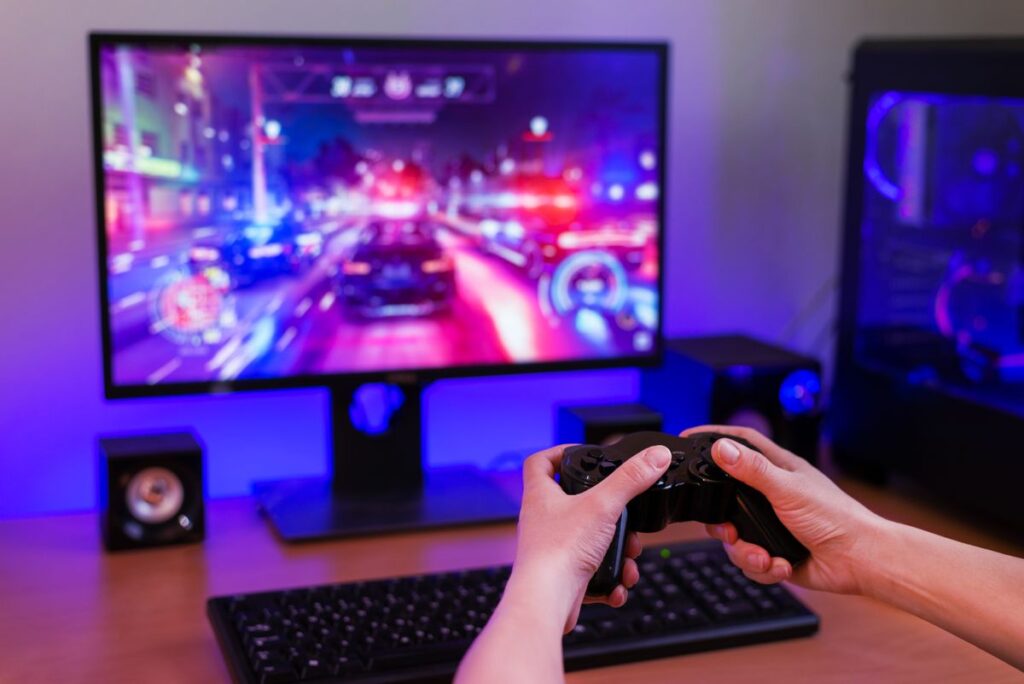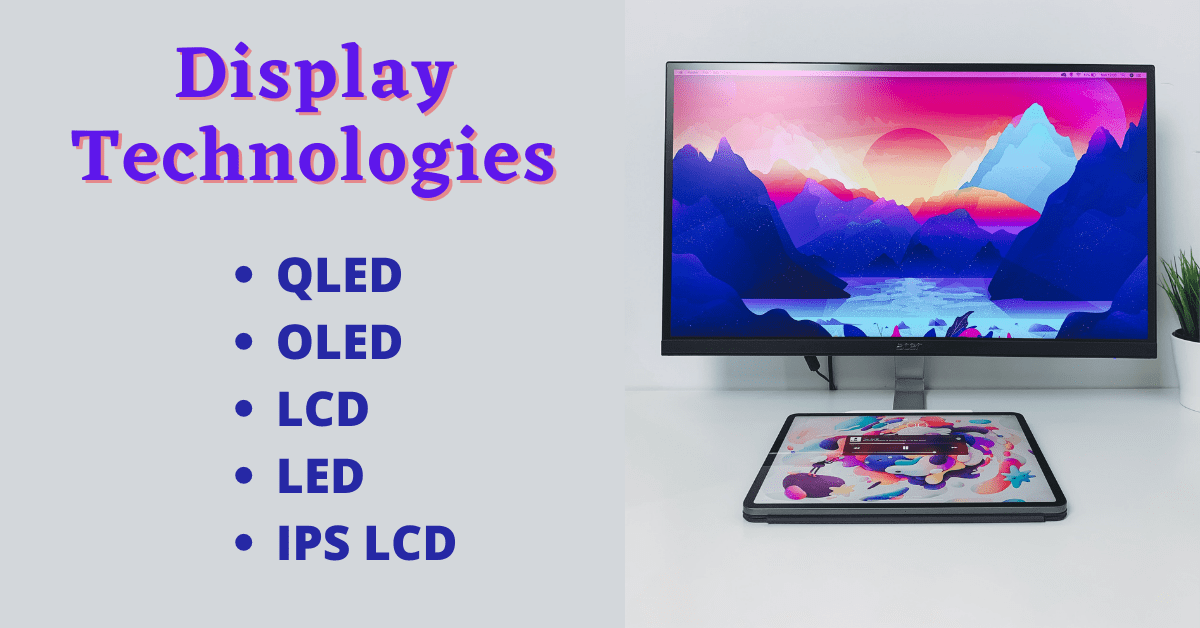Last Updated on August 27, 2022 by Tech Queries Team
Whenever you go to a TV showroom, you will find several models with different technologies like LCD, OLED, LED, etc. Due to that, buyers are often confused while choosing the best product. Therefore, to help you make a quick and better decision, we have explained display technologies and the difference between QLED Vs OLED Vs LCD Vs LED Vs IPS & other technologies as well.
Moreover, we will also be covering display technologies in mobile phones like IPS LCD and AMOLED.
Table of Contents
Display Technologies Explained:
The main part of a TV, Monitor, and Mobile is its screen (or display). These screens are made of different technologies. Therefore, it is called Display Technology. And, engineers have been making significant improvements to the display for providing a better experience for the viewers.
PLASMA TV:
Let’s begin with the technology that has been since the invention of televisions. Plasma display technology is the oldest technology, which is rarely available these days. Invented in the 1950s, these televisions/monitors had a bulky design with a glass screen.
They used to have electron guns that fire red blue and green phosphor-coated dots on the glass screen. These would go horizontally from top to bottom at a high speed, fast enough to create an image. (Watch the Video Below to understand how it works practically)

However, due to the glass display, it used to glare and show reflection, which made it difficult for users to watch the screen in daylight.
The power consumption was more but the color levels were better than LCD. Moreover, it had better refresh rates than most LCD monitors.
Nevertheless, it is outdated technology, as there are many other technologies, which we will be talking about next in this article.
Here is a video by Slow-mo guys (YouTube), showing how Plasma TV works in slow motion.
LCD Display:
Next, let’s talk about LCD displays. LCD full form is Liquid Crystal Display, which replaced the glass screen in the 1970s. The technology was first used in watches & pocket calculators and was later adopted in inventing televisions.
These TVs/Monitors have an LCD display panel with fluorescent lighting that displays the color. In LCD TVs or Monitors, you will not see the black color completely black. Due to the technology used, you will experience a dark greyish shade instead of black pixels.
Also, Check out What is MegaPixel?
However, LCD Monitors were much slimmer and consumed less power than their previous version (Plasma TVs). But, you cannot see the perfect picture from diagonal angles while using LCD Monitors. LCD Monitors are definitely better than Plasma TVs but it is least preferred these days after more advanced technologies have been introduced.

Furthermore, LCD Monitors are developed and classified into several types, like TN, TFT, IPS, and VA. Let’s Discuss them as well.
IPS LCD:
IPS (In-Plane Switching) LCD is the best type of LCD. If you are planning to buy an LCD, then go for IPS LCD. IPS LCDs come with color enhancement technology. Therefore, you will see better color reproduction in IPS LCD, besides the Black color. Moreover, IPS LCD Screen is clear even when you tilt the device. Furthermore, IPS LCD Monitors or Mobiles are thinner than the older LCD models.
More Types of LCD:
TN Panels:
LCD Monitors with TN Panels (Twisted Nomatic Panel) are the cheapest. However, TN Panels have better refresh rates, making them a cheap and good choice for gamers.
TFT (Thin Film Transistors):
TFT Display has better contrast and is mostly used in smaller devices like digital watches, calculators, etc.
LED Display:
LED (Light Emitting Diode) is the latest and most adapted technology. LED Monitors also have a Liquid Crystal Display, but instead of using fluorescent light, they use LED backlight. LED panel has several light diodes that glow when current passes through them. LED TVs can be viewed from different angles as well.

It consumes less power. Moreover, it offers better colors, and even the black light is pure black.
Furthermore, they are slimmer, and a little bit more expensive than the LCD TVs/Monitors.
AMOLED:
The Active Matrix Organic Light-Emitting Diode (AMOLED) is a type of LED display technology, which is used in smartphones.
OLED:
OLED is the latest display technology in the market. Unlike LCD and LED, the OLED display doesn’t have any backlight. Every pixel has an individual light. OLED (Organic Light Emitting Diode) TVs have better response times compared to other technologies, which makes them a perfect choice for watching 3D content. Moreover, they are much slimmer and consume less power. However, OLED TVs and Monitors are very expensive right now.
Check out OLED Televisions on Amazon
- INTELLIGENT TV PROCESSING – The Cognitive Processor XR understands how humans see the real world to deliver intense contrast with deep blacks, high peak brightness, and natural colors.
Quantum Dots (QLED):
Another display technology you need to know is the Quantum Dots. It is the latest technology with improved performance over LCD & LED, with an increase in price as well. Overall, the colors are much brighter and more vibrant. Furthermore, it consumes way less power. QLED TVs are nothing but LCD & LED Monitors with a Quantum Dots layer that improves the performance and picture quality.
Check out QLED Televisions on Amazon
- 4K UPSCALING: Whatever you watch, the Quantum Processor 4K transforms it to 4K with machine learning-based AI
LCD Vs LED Comparision Table:
Mostly, people are confused between choosing LCD and LED Monitors. Hence, here is a table that shows all the differences between LCD and LED.
| LCD ( Liquid Crystal Display) | LED (Light Emitting Diode) |
|---|---|
| Contrast Ratio is Medium | Contrast Ratio is High |
| Low Viewing Angle | Medium Viewing Angle |
| Thick in size | Thin in Size |
| Slower Response | Faster Response |
| Low Price | High Price |
| Higher Power Consumption | Lower Power Consumption |
| Slower Refresh Rates | Faster Refresh Rates |

QLED Vs OLED Comparision Table:
QLED and OLED are the latest technologies in Television. Here is a table that shows the difference between QLED Vs OLED.
| QLED (Quantum Dots Light Emitting Diode) | OLED (Organic Light Emitting Diode) |
|---|---|
| Available in sizes from 49″ to 98″ | Available in 55″ and 65″ size TVs only. |
| Better brightness | Less brightness compared to QLED |
| A better option for bright rooms | Looks better when used in dark rooms |
| The quality of blacks is better than LCD and LED | The quality of blacks is the best |
| No better viewing angles | Better viewing angles |
Conclusion – Which Display Technology is Better?
Let’s conclude this article and talk about the main features of each display technology. The pixels in OLED have their own lighting, and OLED TVs also consume less power while providing the best quality. Therefore, OLED will be our first pick (not considering the budget).
Besides that, you can also go for a QLED, which is almost as good as QLED but quite expensive. For a budget-friendly option, we will choose LED Televisions and Monitors. Now, the only option left is LCD, which is a cheaper option. However, IPS LCD is the best among LCD monitors.
Note that, besides the Display Technology, you must also consider other factors while purchasing a TV or Monitor, like Screen Size, Screen Resolution, Refresh Rate, Connectivity Options, and other factors.
Now that we have Explained Display Technologies, it will be easy for you to choose between QLED Vs OLED Vs LCD Vs LED Monitors. Comment below, which type of television or monitor you would like to purchase.




Wonderful blog! I found it while searching on Yahoo News. Do you have any tips on how to get listed in Yahoo News? I’ve been trying for a while but I never seem to get there! Thanks